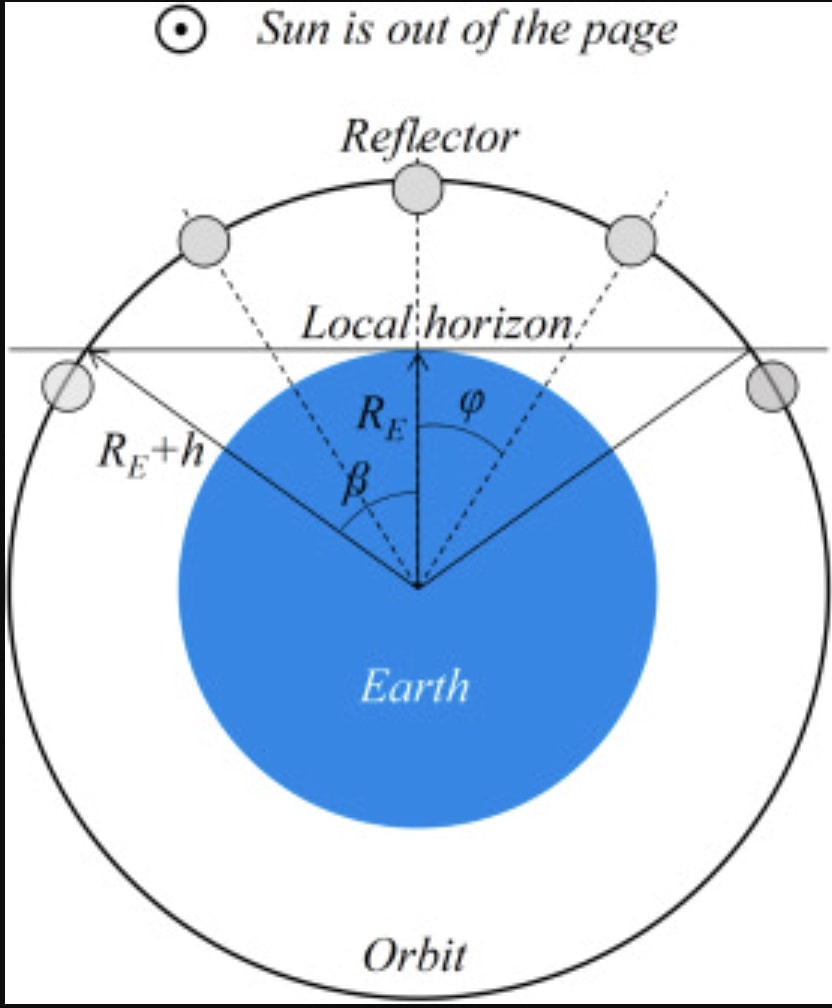A new research paper in the Acta Astronautica journal describes a constellation of mirror satellites to increase the power at the large solar farms on Earth.
Among all cases, the paper found SSO (sun synchronous orbit) and single reflector cases to be superior. A constellation with 20 reflectors could deliver a significant quantity of solar energy to existing solar power farm projects, which may be enhanced even further with strategically placed new solar power farms. Constellations of orbiting solar reflectors could then be seen as analogous to additional solar power farm in space, distributing solar energy globally rather than locally, enhancing the capacity of terrestrial solar energy.
The paper has only considered a single orbit altitude and a limited set of possible orbital configurations, which, nevertheless, has demonstrated the potential of solar reflector constellations to enhance terrestrial solar energy generation. Alternative constellation geometries could enhance this further for a truly global clean energy generation by orbiting solar reflector.

Nextbigfuture covered previous 2012 proposals to put lightweight mirrors up in space to direct sunlight onto large solar farms at night.
In 2018, China’s Chengdu was looking to launch satellites to light up the city at night. Lighting up a megacity at night is only step one. China has the most solar farms in the world. Large 5-gigawatt solar farms have the area of a megacity. China is preparing to triple the capital value of its solar farms. A constellation of $37 billion of solar mirror satellites will boost several large solar farms and would twice the power and efficiency of the Three Gorges Dam.
Orbiting solar reflectors (OSRs) are flat, thin and lightweight reflective structures (thin lightweight mirrors) that are proposed to enhance terrestrial solar energy generation by illuminating large terrestrial solar power plants locally around dawn/dusk and during night hours. The mirror would boost ground based solar farms only generating power during daylight. However, the quantity of solar energy delivered to the Earth’s surface remains low due to short duration of orbital passes and the low density of the reflected solar power due to large slant ranges. To compensate for these, the paper proposes a constellation of multiple reflectors in low-Earth orbit for scalable enhancement of the quantity of energy delivered. Circular near-polar orbits of 1000 km altitude in the terminator region are considered in a Walker-type constellation for a preliminary analysis. Starting from a simplified approach, the equations of Walker constellations describing the distribution of the reflectors are first modified by introducing a phasing parameter to ensure repeating pass-geometry over solar power farms. This approach allows for a single groundtrack optimisation to define the constellation, which was carried out by a genetic algorithm for single and two reflectors per orbit with an objective function defined as the total quantity of energy delivered per day, to existing and hypothetical solar power projects around the Earth. When full-scale constellations are considered with a number of reflectors, the quantity of solar energy delivered is substantial in the broader context of global terrestrial solar energy generation.

Brian Wang is a Futurist Thought Leader and a popular Science blogger with 1 million readers per month. His blog Nextbigfuture.com is ranked #1 Science News Blog. It covers many disruptive technology and trends including Space, Robotics, Artificial Intelligence, Medicine, Anti-aging Biotechnology, and Nanotechnology.
Known for identifying cutting edge technologies, he is currently a Co-Founder of a startup and fundraiser for high potential early-stage companies. He is the Head of Research for Allocations for deep technology investments and an Angel Investor at Space Angels.
A frequent speaker at corporations, he has been a TEDx speaker, a Singularity University speaker and guest at numerous interviews for radio and podcasts. He is open to public speaking and advising engagements.
>>> Read full article>>>
Copyright for syndicated content belongs to the linked Source : Next Big Future – https://www.nextbigfuture.com/2024/02/orbiting-thin-space-mirrors-could-boost-ground-based-solar-power.html































